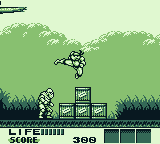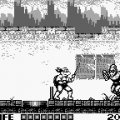- Teenage Mutant Ninja Turtles (NES)
- Teenage Mutant Ninja Turtles: The Arcade Game
- Teenage Mutant Ninja Turtles: World Tour
- Teenage Mutant Ninja Turtles: The Manhattan Missions
- Teenage Mutant Ninja Turtles III: The Manhattan Project
- Teenage Mutant Ninja Turtles: Turtles in Time
- Teenage Mutant Ninja Turtles: Hyperstone Heist
- Teenage Mutant Ninja Turtles: Fall of The Foot Clan
- Teenage Mutant Ninja Turtles II: Back From The Sewers
- Teenage Mutant Ninja Turtles III: Radical Rescue
- Teenage Mutant Ninja Turtles: Tournament Fighters (Genesis)
- Teenage Mutant Ninja Turtles: Tournament Fighters (SNES)
- Teenage Mutant Ninja Turtles: Tournament Fighters (NES)
- Teenage Mutant Ninja Turtles (Console – 2003)
- Teenage Mutant Ninja Turtles (GBA – 2003)
- Teenage Mutant Ninja Turtles 2: Battle Nexus (Consoles)
- Teenage Mutant Ninja Turtles 2: Battle Nexus (GBA)
- Teenage Mutant Ninja Turtles: Mutant Melee
- Teenage Mutant Ninja Turtles 3: Mutant Nightmare (Console)
- TMNT (2007) – Console
- TMNT (2007) – NDS and PSP
- Teenage Mutant Ninja Turtles 3: Mutant Nightmare (DS)
- TMNT (GBA)
- Teenage Mutant Ninja Turtles: Smash-Up
- Teenage Mutant Ninja Turtles: Arcade Attack
- Teenage Mutant Ninja Turtle (Plug and Play)
- Teenage Mutant Ninja Turtles Fast Forward: Ninja Training NYC / TMNT: Power of 4
- TMNT: Ninja Adventures – Mini-Game and Activity Centre
- Teenage Mutant Ninja Turtles: The Ninja Tribunal / The Shredder Reborn
- Teenage Mutant Ninja Turtles: Double Damage
Though released in between the Genesis and SNES versions of Tournament Fighters, Konami’s next TMNT adventure on the Game Boy would be an all-new exclusive adventure, not partaking in the Tournament Fighters marketing that was heavily in gear for the holiday season. Returning to its sidescrolling roots yet again, Radical Rescue is actually something of a milestone for Konami, a discovery of a genre which they would take advantage of some years later.
Directed by long time Konami producer and key figure Hiroyuki Fukui, Radical Rescue is a side scrolling non-linear adventure game, putting the Ninja Turtles in the midst of a maze created by Shredder, who has escaped from his holding cell and kidnapped April once again. But for the first time ever, Leonardo, Raphael and Donatello have also been captured and locked up in Shredder’s hideout, leaving only Mikey to come to the aid of his brothers and best friend.
To start, Mikey is the only character available, and it’s up to him to locate and free his brothers. Doing so requires some detective work, as keys are required to open their cells. Keys are only made available after defeating a boss character, and defeating them also opens up all new areas. The turtles themselves need to cooperate appropriately to venture through the large maze by making use of their individual skills: Leo can drill into the ground with his katana, Raph has the ability to shrink into his shell and enter narrow passageways and Don has the ability to climb walls. Mikey, being the best of them anyway, can hover through the air by spinning his nunchuks.
The most immediate comparison that can be drawn is naturally Metroid II, being that they share a home on the Game Boy. The set up of the game is very similar – a large open world, with unlockable skills (in this case in the form of characters), new areas from defeating bosses, and hidden items in boxes and crates. The boss battles are increasingly challenging as the game progresses and using the four turtles is required to survive, but the moment one turtle is defeated, the game is over. Unlike the prior game, there is no chance of rescuing your brother a second time around.
Being that it shares similarities with a Metroid game, it also retains a lot of the issues found in that series’ Game Boy iteration. The limited view is a drawback to a large open world game that requires exploration, and even though there is a sort of semi-linear structure, getting lost happens more than it should. Without the use of color, locations also look too similar, which becomes the largest issue with the game. Apart from the exterior section of the beginning moments, Shredder’s fortress recycles an all-black background with a gray warehouse-type setting, with minimal changes made between locations. Radical Rescue also has some length to it, so you are dealing with literally hours of navigating similar locations to find the bosses. The game helpfully features a password system to resume gameplay.
In terms of presentation, Radical Rescue scores high marks and is among the best in the series overall, handheld or console. Similar to what was done in Symphony of the Night four years later, the game’s prologue hearkens back to the classic template, being seemingly another side scroller through a standard level structure. It’s only when Mike arrives inside the fortress that the game reveals itself to be something completely new to the series, and a very welcome change at that. The character designs are based heavily on Michael Dooney’s art and are among the best sprite work in a TMNT game, though the bosses contrast their darker appearance, being based heavily on their more cartoony toy versions. Even though the boss roster is smaller than usual, it is certainly the most interesting, using almost exclusively characters from Adventures or the toy line. Regulars Rocksteady and Bebop are not to be found, explained as being still in prison for the crimes committed in Back From The Sewers. The music is among the better scores found in a TMNT game, featuring the tried and true power pop affair, though with a noticeably darker edge to many passages. The soundtrack was handled by M. Matsuhira.
It’s definitely interesting to see an early precursor to Symphony of the Night come in the form of a TMNT game four years prior to the Castlevania classic, but it should not come as a surprise that many of the staff members of Radical Rescue would be part of SotN’s production team, along with Hiroyuki Fukui in a producer role. Radical Rescue is a long, challenging and interesting game that on paper is suited for a handheld system, but it is sadly held back by the issues that come along with that platform and lack of diversity in the world structure. The graphics, the sound, and the challenge have held up great. however, and it’s a more than worthy addition to any Game Boy collection. No changes were made to the Japanese release for the title, though it was released as Teenage Mutant Ninja Turtles 3: Turtles Kiki Ippatsu (“Turtles in Danger”).


